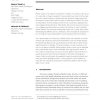Free Online Productivity Tools
i2Speak
i2Symbol
i2OCR
iTex2Img
iWeb2Print
iWeb2Shot
i2Type
iPdf2Split
iPdf2Merge
i2Bopomofo
i2Arabic
i2Style
i2Image
i2PDF
iLatex2Rtf
Sci2ools
PRESENCE
2008
2008
A High-End Virtual Reality Setup for the Study of Mental Rotations
Mental rotation is the capacity to predict the orientation of an object or the layout of a scene after a change in viewpoint. Previous studies have shown that the cognitive cost of mental rotations is reduced when the viewpoint change results from the observer's motion rather than the object or spatial layout's rotation. The classical interpretation for these findings involves the use of automatic updating mechanisms triggered during self-motion. Nevertheless, little is known about how this process is triggered and particularly how sensory cues combine in order to facilitate mental rotations. The previously existing setups, either real or virtual, did not allow disentangling the different sensory contributions, which motivated the development of a new high-end virtual reality platform overcoming these technical limitations. In the present paper we will start by a didactic review of the literature on mental rotations and expose the current technical limitations. Then we will ...
| Added | 14 Dec 2010 |
| Updated | 14 Dec 2010 |
| Type | Journal |
| Year | 2008 |
| Where | PRESENCE |
| Authors | Alexandre Lehmann, Manuel Vidal, Heinrich H. Bülthoff |
Comments (0)

